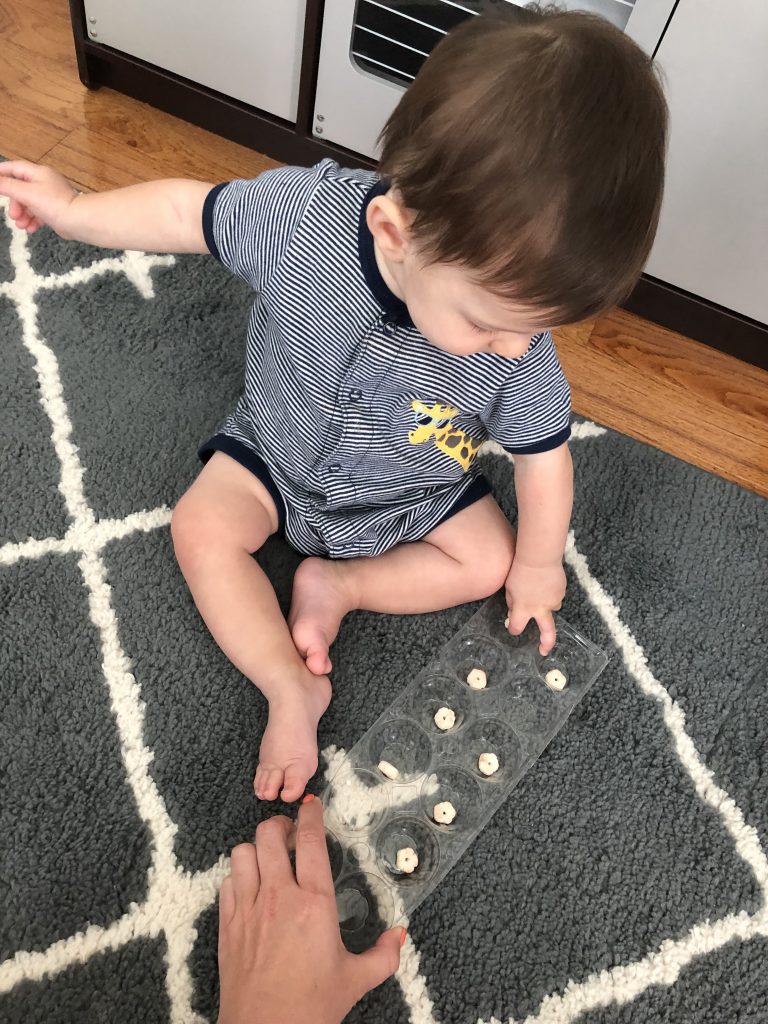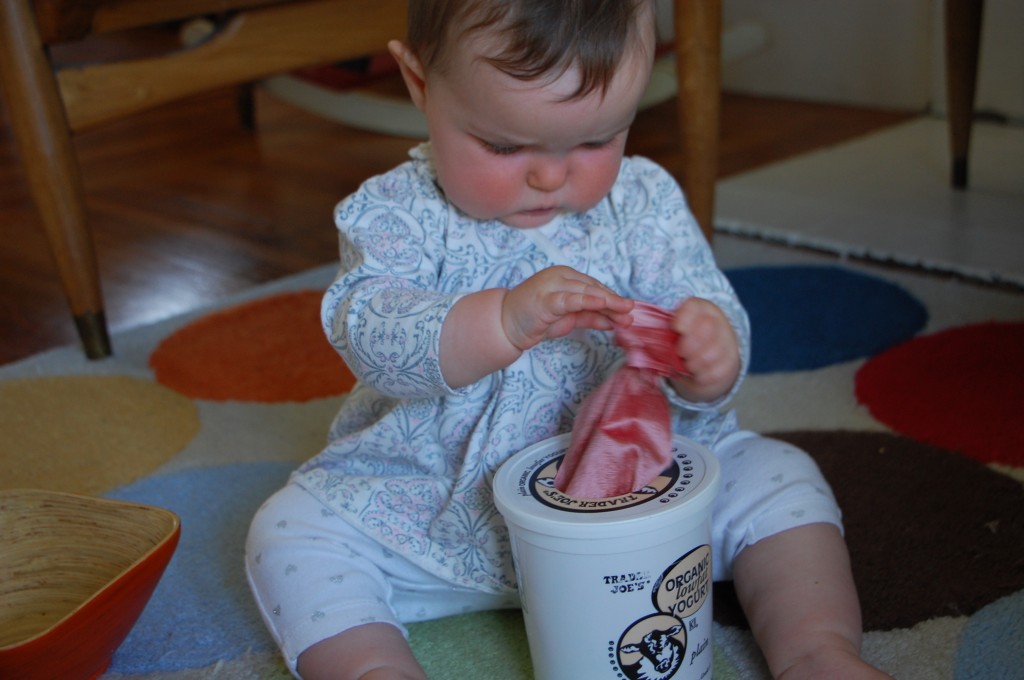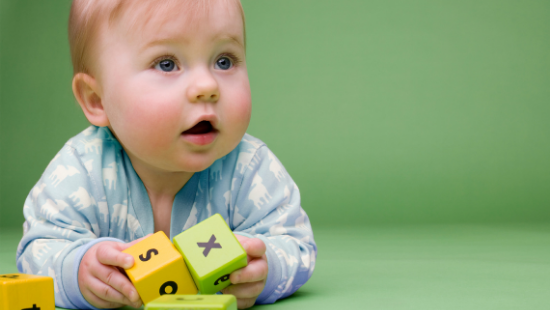A baby will go through many different developmental stages as they grow and develop new skills. One of the milestones that you will see emerge is their use of pincer grasp, a basic fine motor skill.
Fine motor skills involve the small muscles in the hands and fingers, allowing them to grasp and manipulate objects. They allow us to produce movement, coordination, and strength in our hands as we use them for everyday life.
Related: Fine Motor Play Activities For Your 3 to 6 Month Old Baby
What is Pincer Grasp?
As babies grow, their grasp will develop from using their whole hand, palm, and fingers in order to pick up larger items, to a more precise ability to pick up tiny items between their fingers.
This precise grasp using only the thumb and pointer finger is called a pincer grasp. It allows them to pick up small objects for self-feeding and playing.
They’ll bring their thumb and pointer finger together in a pinching motion and no longer need the use of their whole hand.
Young babies will be able to use this pincer grasp to pick up larger sized items (cheerios, cubes) between their two fingers.
As they get older, they will be able to more precisely match those two fingers together to pick up tiny objects (small beads, crumbs) between them.
What age does pincer grasp develop in babies?
Anywhere between 7 and 12 months, your baby will start to develop this pincer grasp.
During the earlier months of this stage (7 to 9 months), your baby will be able to bring their thumb and pointer finger together, but may not yet have the precision to pick up objects.
As they practice (9 to 12 months), their pincer grasp will continue to refine, making them able to grab and release small objects for self-feeding and play.

The Types of Grasps
Before your baby coordinates his thumb and index finger, he works on other types of grasps that sets the stage for the pincer grasp.
Grasping starts around six months and continues to become more advanced. Your baby gradually picks up smaller objects through these different types of grasps.
- Raking Grasp: Around six months old, your baby will try to pick up a piece of food by raking it towards her with her hand. Then, she covers it with her palm and squeezes the object into her first. This early form of the pincer grasp is called the raking grasp.
- Crude Pincer Grasp: Over time, around seven to eight months old, your baby’s hand-eye coordination is better. Now, she can transfer bits of food from hand to hand, and she can pick them up with her two fingers. However, instead of using the thumb and forefinger, she grasps objects using the pads of her thumb and index finger.
- Superior Pincer Grasp: Finally, the end stage is the pincer grasp, so your baby can pick up small items with the tips of her thumb and index finger. Now, all the little things in your house are fair game for your baby!
Activities to Practice Pincer Grasp For Your Baby
For most babies, the development of a pincer grasp will happen naturally as they understand how their body works and practice through playtime and mealtime. However, some infants may need a little help to guide these skills.
Here are a few activities that you can do to practice this motor skill with your baby.
Remember to always supervise your child when using small objects that can be potential choking hazards.
1. Self-Feeding

One of the biggest motivators for a young child is food. So why not start with edible items that your baby will be excited to grab for?
The earliest finger foods for a baby to eat are Gerber Puffs. They dissolve easily in their mouths so they are not choking hazards. If your baby has already moved on to cereal, like Cheerios, you can try those too.
Simply scatter the cereal around their tray and let them practice picking it up with two fingers.
It’s important not to cluster too many up in one area because that will give your baby the opportunity to use a raking motion (or grasp all of the items at once) with their whole hand. So make sure you only have one or two accessible at a time.

If your baby needs a bit of assistance, use a hand-over-hand technique by using your hand to guide them. Simply hold down their last 3 fingers so that they are forced to use the thumb and pointer together.
Related Post: Why You Should Let Your Baby Feed Themselves
2. Use Activity Boards
You can find so many activity boards on the market for infants. Not only do these keep your baby busy, but it’s great for developing the pincer grasp.
Activity boards and boxes feature buttons to poke, switches, flips, and dials to turn. Some busy books have Velcro straps to pull, and these toys are great for critical thinking and learning cause-and-effect.
3. Pom Pom Whisk

This pompom whisk activity is simple and you only need 2 items. It requires your baby to use a pincer grasp (thumb and pointer finger together) to pull out the pompoms.
Just stuff a bunch of one-inch pompoms in a kitchen whisk and watch them be entertained while pulling them out with their little fingers.
Read the full post about this activity here: Pom Pom Whisk Activity for Babies
4. Items in an Egg Crate

Egg crates are great because it forces your child to only use their pincer fingers to get the object out.
Use edible items to avoid a choking hazard. Puffs are a great choice for this activity.
You’ll probably need to hold down the egg crate as your little one attempts to get the cereal out.
5. Turning Pages
Reading is a crucial part of your baby’s development since it encourages language development. The more words a child hears, the better their reading and language future is.
Work with your baby to our pages of a book; you will have to guide their hands. Start with board books that have the large, chunky pages since they are easier to separate and turn. Over time, your toddler will one day flip the pages of books with thinner pages.
Turning pages may seem a bit advanced for an infant, but board books are meant for babies to flip around. It also helps your baby think about using independent fingers!
6. Stickers

Stickers are a great way to get your baby to use their pincer grasp.
At this age, you will definitely need to assist them by peeling back the sticker. Then, allow them to pinch the end of the sticker and peel it off the sheet.
7. Balls of All Sizes
Make sure you have balls that are different sizes and textures. Some may be larger but others are lightweight and easy to push. The smaller ones should be small enough for your baby to squeeze.
Squeezing and grasping with your baby’s entire hand will strengthen necessary muscles need to create the pincer.
8. Tissues

You’ll start to see your baby’s curiosity emerge throughout these months. One thing that they will love to do is pick out tissues from the box.
Although this can be a bit of a waste of paper products, your baby will love it. Grasping a tissue with two fingers can encourage pincer grasp well.
You can also use play scarves to have the same effect of this pincer grasp activity.
9. Play with Blocks

Introducing blocks of various sizes and textures encourages your baby to grasp items with their hands and explore.
One inch wooden blocks are perfect, but blocks offering a variety of textures offer a lot of sensory input as well! You want them to be small enough that they can pick up with their two fingers.
Related Post: Fine Motor Skills Activities for Your 9 – 12 Month Old baby
10. Point Together
Pointing teaches your baby how to use individual fingers. Typically, babies won’t start pointing on their own until nine months or later, but you can encourage this by reading books together and pointing to pictures.
Not only does this encourage language skills and a love of reading early, but it gives your baby a chance to learn about his fingers and practice using one independently from the others.
Try reading this adorable Melissa & Doug Poke-a-Dot Book; your baby has to pop the buttons in the book. It’s so fun even for toddlers and preschoolers.
11. Practice with Different Shapes
Give your baby items that are different shapes to practice holding their hands differently. Try handing you infant cylinder shape objects like a paper towel roll or a straw. You also can try rings and stacking.

Grab some chunky puzzles that have large knobs on the top. This shape helps your baby learn how to form an “o” shape with their hand and work on needed muscles. I love the Melissa & Doug Farm Animals Jumbo Puzzle.
. . . . .
Now that you know when the pincer grasp develops, you should be able to identify and practice your baby’s pincer grasp with these fun activities listed above. Let me know if you have any more fun ideas in the comments section!

